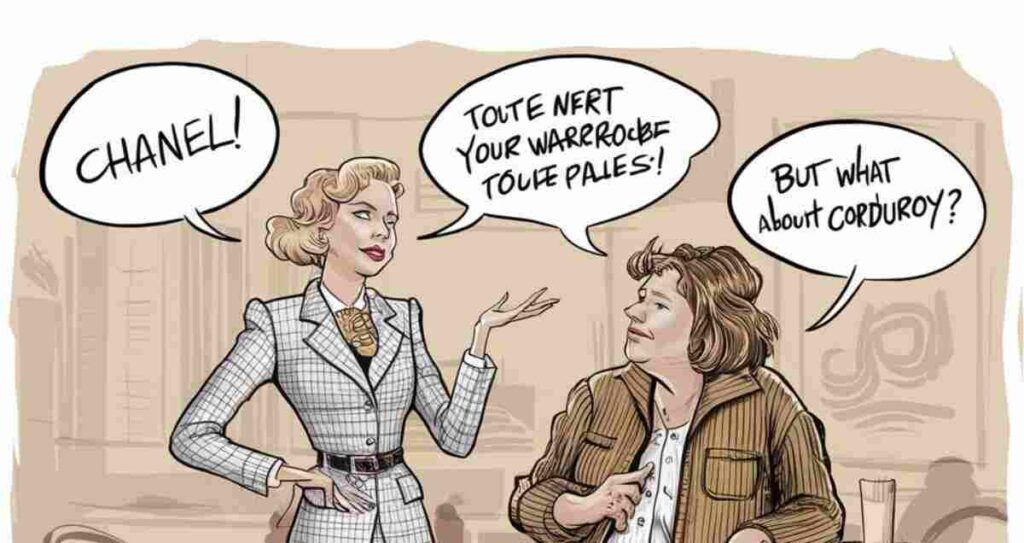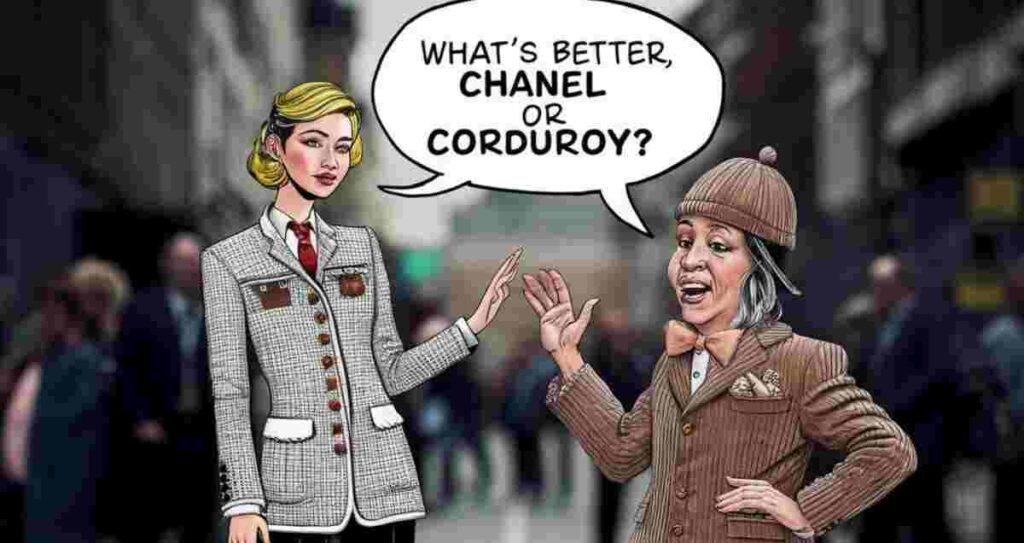What’s Better Chanel Or Corduroy explores the comparison between two iconic fabrics—Chanel’s luxurious bouclé and corduroy’s cozy ridged texture. It delves into their history, style applications, and practicality, helping readers choose the perfect fabric for their needs.
What’s Better Chanel Or Corduroy—luxury meets comfort! Discover how these fabrics differ in style, function, and appeal. Which one fits your wardrobe best? Let’s find out.
Chanel represents timeless sophistication, often seen in couture designs, while corduroy brings casual charm with its ribbed texture and durability. Choosing between them depends on the occasion, personal style, and comfort preferences.
Chanel or Corduroy? Which Fabric Suits Your Lifestyle Best?

Fashion often demands choices that reflect personality, lifestyle, and occasion. Among the many debates in style, one timeless question arises: What’s Better Chanel Or Corduroy These fabrics are iconic in their own right but serve vastly different purposes. Chanel exudes luxury and sophistication, while corduroy offers a cozy, vintage charm that has stood the test of time.
In this comprehensive guide, we’ll explore their history, features, uses, and care tips. By the end, you’ll have a clear idea of which fabric suits your wardrobe—and your personality—best.
Understanding Chanel Fabric
Chanel isn’t just a luxury brand; it’s also associated with a specific type of bouclé fabric that’s rich in texture and heritage. Here’s what makes Chanel fabric special:
History and Origin
- Founded by Gabrielle “Coco” Chanel: The Chanel brand popularized this bouclé material in the 1950s. Bouclé, a French word meaning “looped,” describes the textured weave that gives Chanel fabric its signature look.
- A staple in couture: Chanel fabric is often used in tailored jackets, dresses, and skirts, making it synonymous with high-end fashion.
Key Features
- Texture: The bouclé weave incorporates loops and curls, creating a soft, multidimensional surface.
- Material: It often blends wool with silk, cotton, or synthetic fibers for durability and elegance.
- Luxurious Feel: Chanel fabric is lightweight yet structured, offering comfort without sacrificing style.
| Feature | Details |
|---|---|
| Material | Wool blends, often with silk or cotton |
| Primary Use | High-fashion garments like jackets and suits |
| Texture | Looped, textured weave |
| Care | Requires professional dry cleaning |
Understanding Corduroy Fabric
Corduroy is a fabric rooted in utility and everyday wear. Known for its distinctive ridged texture, it has evolved into a stylish yet functional choice for various occasions.
History and Origin
- First used in ancient Egypt: Corduroy’s earliest ancestor, “fustian,” was a durable, ridged fabric.
- Popularity in workwear: During the 18th and 19th centuries, corduroy became the fabric of choice for laborers due to its durability.
- Modern resurgence: Today, corduroy is a staple in casual and vintage-inspired fashion.
Key Features
- Texture: Corduroy features raised “wales” or ridges, which give it a distinct tactile feel.
- Material: Typically made from cotton or cotton blends, making it breathable and sturdy.
- Variety: Available in different wale sizes, from fine “pincord” to wide, chunky “elephant cord.”
| Feature | Details |
|---|---|
| Material | 100% cotton or cotton blends |
| Primary Use | Casual wear like pants, jackets, and skirts |
| Texture | Ribbed with raised ridges |
| Care | Machine washable, but air drying is recommended |
Chanel vs. Corduroy: Key Differences

Fabric Composition and Texture
- Chanel: Luxurious, intricate bouclé with loops and soft texture.
- Corduroy: Durable, ridged surface ideal for everyday use.
Style and Versatility
- Chanel: Suited for formal occasions, business attire, and high-fashion settings.
- Corduroy: Perfect for casual outings, vintage-inspired looks, and relaxed fits.
Comfort and Practicality
- Chanel: Lightweight and breathable but delicate, requiring careful handling.
- Corduroy: Warm and sturdy, ideal for colder months and regular wear.
| Feature | Chanel Fabric | Corduroy Fabric |
|---|---|---|
| Luxury Level | High | Moderate |
| Durability | Moderate | High |
| Maintenance | Dry clean only | Machine washable |
| Best For | Formal events, couture fashion | Casual wear, vintage styles |
How to Style Chanel and Corduroy
Styling Chanel
- Pair a Chanel-inspired bouclé jacket with tailored trousers for a polished look.
- Add pearl jewelry and a classic clutch for an elegant finish.
- Combine a Chanel-style skirt with a silk blouse for timeless sophistication.
Styling Corduroy
- Match corduroy trousers with a turtleneck sweater for a cozy, retro vibe.
- Pair a corduroy jacket with jeans and boots for casual yet stylish outerwear.
- Opt for corduroy overalls with a graphic tee for a playful, vintage-inspired outfit.
Case Study: When to Choose Chanel or Corduroy

Case Study 1: Emily’s Boardroom Presentation
Emily needed a commanding outfit for a corporate presentation. She chose a Chanel-inspired jacket paired with black trousers, exuding authority and elegance.
Result: Her confidence shone through, and her style left a lasting impression.
Case Study 2: Jake’s Weekend Getaway
For a cozy weekend getaway, Jake opted for corduroy pants and a flannel shirt. The outfit kept him comfortable during a chilly evening bonfire.
Result: He felt relaxed and received compliments on his laid-back style.
Care Tips for Both Fabrics
Caring for Chanel
- Cleaning: Dry clean only. Avoid water-based cleaning methods to prevent damage.
- Storage: Hang or fold carefully to avoid creasing.
Caring for Corduroy
- Cleaning: Machine wash in cold water, then air dry to maintain texture.
- Storage: Fold or hang to preserve the ridges. Avoid overloading the closet.
Conclusion
Choosing What’s Better Chanel Or Corduroy depends on your needs and lifestyle. If you’re drawn to luxury and refinement, Chanel fabric is unmatched in its elegance. For practicality, warmth, and vintage appeal, corduroy is the obvious winner.
Both fabrics have their strengths, so why not embrace both? With Chanel, you’ll own pieces that make a statement at formal events, while corduroy offers comfort and style for casual days.
David Mark is a fashion aficionado and writer for Fashion Burst, where he delivers insightful content on the latest trends and style tips. With a keen eye for detail and a passion for all things fashion, David provides readers with expert advice and trend-setting ideas. His engaging posts help you stay ahead of the curve and refine your personal style with confidence and flair.
